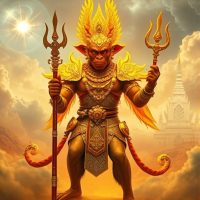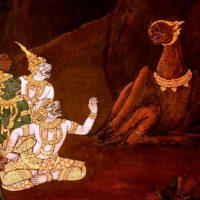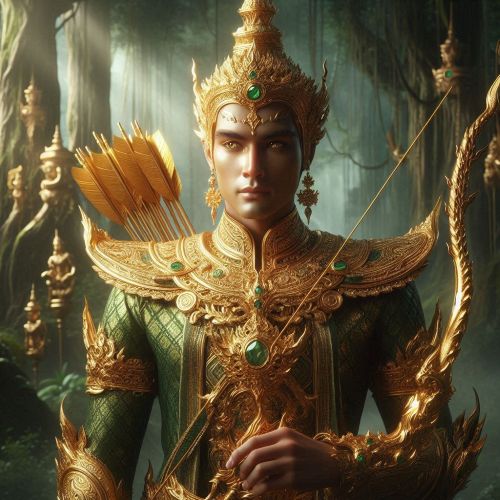Pali Thirat : The Monkey King
Listen
At a glance
| Description | |
|---|---|
| Origin | Thai Mythology |
| Classification | Demigods |
| Family Members | Indra (Father), Sugripa (Brother) |
| Region | Thailand |
| Associated With | Warrior, Leadership, Royalty |
Pali Thirat
Introduction
Pali Thirat, also known as Phali, Palee, or Vali, is one of the most fascinating figures in Thai mythology and a central character in the Ramakien, Thailand’s adaptation of the Indian Ramayana. As the king of the monkey kingdom Khitkhin (Kishkindha) and the uncle of the legendary warrior Hanuman, Pali Thirat stands as a symbol of strength, leadership, and divine justice. His story intertwines divine intervention, brotherly rivalry, and moral complexity—qualities that make him one of the most humanly flawed yet divinely powerful figures in Thai legend. Through centuries of oral storytelling, temple murals, and masked dance performances, Pali Thirat’s saga continues to embody the timeless struggle between power, loyalty, and destiny in Thai cultural heritage.
Physical Traits
In traditional Thai depictions, Pali Thirat is portrayed as a mighty vanara—part monkey, part divine being—with immense physical stature and golden fur that glows with celestial radiance. His physique symbolizes raw power and agility, traits that make him both a warrior and a ruler. Unlike ordinary monkeys, Pali Thirat’s body bears the marks of divine craftsmanship—muscular limbs, fangs that gleam with supernatural strength, and eyes that radiate authority. Thai temple art and Khon performances often show him wearing intricate royal armor encrusted with gold and jewels, denoting his status as the monkey king. He wields a divine trident granted by Phra Isuan (Lord Shiva), a weapon imbued with mystical energy that allows him to absorb half the strength of any foe he battles. This combination of majesty and menace reinforces his dual nature—a creature of divine purpose but mortal passion.
Family
The story of Pali Thirat is deeply shaped by family ties that define his triumphs and tragedies alike. He is the elder brother of Sukhrip (Sugriva), with whom he shares a complicated and often hostile relationship. Their parents are King Khodam (Kesari) and Kala Acana (Anjana), both celestial beings linked to the divine pantheon. Pali’s wife, Nang Montho (Tara), is a figure of grace and wisdom, whose counsel often tempers his impulsive nature. Together they have a son, Ongkhot (Angada), who later plays a crucial role in the wars of the Ramakien.
However, family for Pali Thirat is both his strength and downfall. His conflict with Sukhrip stems from misunderstandings and ambition, leading to Pali’s eventual exile and death. Adding to this tangled lineage is his nephew Hanuman, born to his brother and raised under his influence. Hanuman’s later allegiance to Phra Ram (Rama) and Sukhrip creates a moral paradox that underscores Pali’s own divided loyalties. Despite his flaws, Pali Thirat’s love for his kin and his sense of royal duty give him the emotional depth that defines great mythic kings.
Other names
Pali Thirat is known by several names across Southeast Asia, each emphasizing a different aspect of his character. In the Thai Ramakien, he is called “Phra Phali Thirat”—the divine monkey king. In the Sanskrit tradition of India, he is referred to as “Vali,” while in other Southeast Asian versions such as the Khmer Reamker and the Lao Phra Lak Phra Lam, his name appears as “Palee” or “Phali.” These variations illustrate the regional spread and adaptation of the epic, where local cultures infused the tale with their unique spiritual and linguistic essence. Regardless of name, the core identity remains consistent: a warrior-king blessed with divine power yet burdened by human emotion.
Powers and Abilities
Pali Thirat’s abilities are a blend of divine blessing and natural prowess. His most remarkable power comes from his magic trident, bestowed by Phra Isuan, which allows him to absorb half the strength of any opponent who dares challenge him. This makes him nearly invincible in combat. His agility rivals that of the wind, and his voice—said to shake the heavens—commands armies of monkey warriors who fight under his banner.
Beyond physical strength, Pali Thirat is also a strategist and a leader of exceptional intelligence. His ability to inspire loyalty among his followers and his skill in warfare establish him as more than just a brute force; he is a tactician who understands both battle and governance. Some legends even attribute healing knowledge and spiritual awareness to him, linking him to Chomphuphan (Jambavan), the wise bear who serves as a healer in the monkey army. Together, these traits elevate Pali Thirat from a mere warrior to a symbol of divine kingship—an archetype of the ruler who must balance might with morality.
Modern Day Influence
Pali Thirat’s influence continues to echo through Thai culture, where myth and art remain intertwined. In the grand murals of Wat Phra Kaew (Temple of the Emerald Buddha) in Bangkok, Pali’s battles and royal scenes are vividly painted, immortalizing his valor and moral complexity. The traditional Thai masked dance known as Khon features Pali Thirat as a principal character, his role performed with elegant gestures and symbolic movement that capture both his power and his tragic destiny.
In literature and education, the Ramakien remains a cornerstone of Thai heritage, with Pali Thirat often studied as a model of leadership, loyalty, and justice. His character also appears in children’s books, animations, and contemporary visual arts, ensuring that his story remains alive for new generations. Beyond entertainment, Pali Thirat’s tale serves as a moral parable: a reminder that even those blessed by the gods are not free from the burdens of pride, jealousy, and redemption.
In spiritual and philosophical contexts, Pali Thirat is sometimes invoked in rituals for courage and protection. His name symbolizes endurance through adversity and the importance of reconciling one’s strength with compassion. Whether through temple art, theater, or modern reinterpretations, the monkey king’s presence continues to define Thailand’s mythic identity—bridging the ancient and the modern, the divine and the human.
Related Images
Source
Wikipedia contributors. (2004, April 27). Ramakien. Wikipedia. https://en.wikipedia.org/wiki/Ramakien
Godchecker. (2023, June 15). PHALI – the Thai God (Thai mythology). https://www.godchecker.com/thai-mythology/PHALI/
Scribd. (2025, May 23). The Pali Imaginaire of Pre Modern Burmese. https://www.scribd.com/document/522794374/The-Pali-Imaginaire-of-Pre-Modern-Burmes
Wikipedia contributors. (2004, May 29). Thai literature. Wikipedia. https://en.wikipedia.org/wiki/Thai_literature
Thaimissions.info. (n.d.). Contextualizing with Thai Folk Buddhists. https://www.thaimissions.info/gsdl/collect/thaimiss/index/assoc/HASH01e9.dir/doc.pdf
Thailex.info. (2011, September 25). THAILEX – Thailand Travel Encyclopedia. https://www.thailex.info/THAILEX/THAILEXENG/LEXICON/m.htm
Bhumibol, A. (1999). The Ramakien: Thailand’s National Epic. Bangkok: Thai Cultural Press.
Wyatt, D. K. (2003). Thailand: A Short History. Yale University Press.
Terwiel, B. J. (2012). Monks and Magic: An Analysis of Religious Ceremonies in Central Thailand. Silkworm Books.
Keyes, C. F. (1987). Thailand: Buddhist Kingdom as Modern Nation-State. Westview Press.
Srisakra, V. (2001). Thai Traditional Performing Arts and Mythology. Bangkok: Chulalongkorn University Press.
Frequently Asked Questions
What is lorem Ipsum?
I am text block. Click edit button to change this text. Lorem ipsum dolor sit amet, consectetur adipiscing elit. Ut elit tellus, luctus nec ullamcorper mattis, pulvinar dapibus leo.
What is lorem Ipsum?
I am text block. Click edit button to change this text. Lorem ipsum dolor sit amet, consectetur adipiscing elit. Ut elit tellus, luctus nec ullamcorper mattis, pulvinar dapibus leo.
What is lorem Ipsum?
I am text block. Click edit button to change this text. Lorem ipsum dolor sit amet, consectetur adipiscing elit. Ut elit tellus, luctus nec ullamcorper mattis, pulvinar dapibus leo.
What is lorem Ipsum?
I am text block. Click edit button to change this text. Lorem ipsum dolor sit amet, consectetur adipiscing elit. Ut elit tellus, luctus nec ullamcorper mattis, pulvinar dapibus leo.
What is lorem Ipsum?
I am text block. Click edit button to change this text. Lorem ipsum dolor sit amet, consectetur adipiscing elit. Ut elit tellus, luctus nec ullamcorper mattis, pulvinar dapibus leo.







